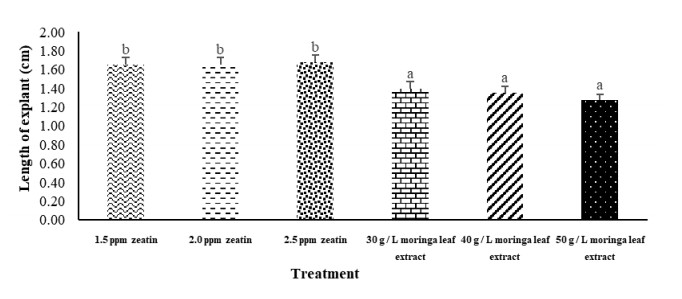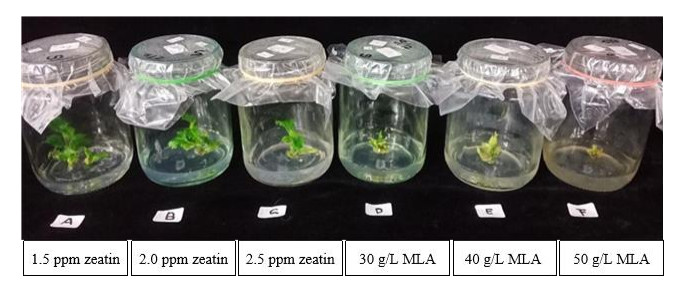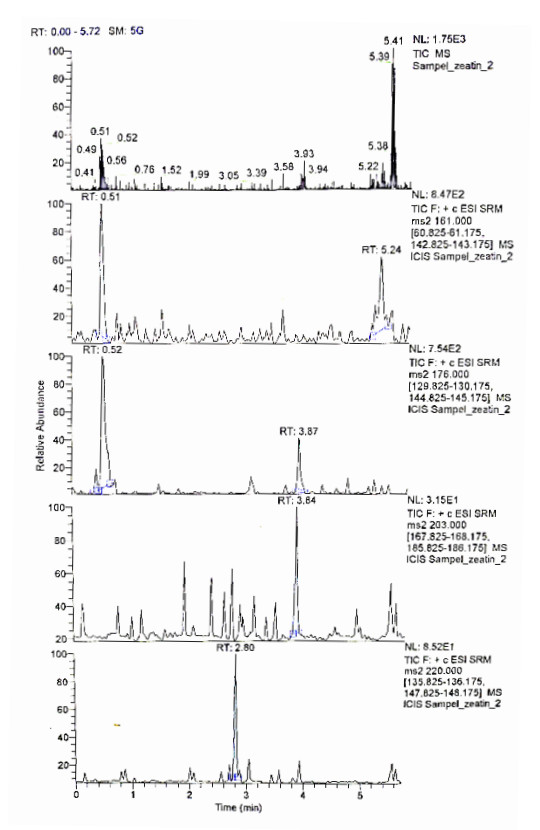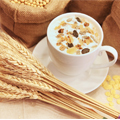The aims of this project were to: 1) compare the antimicrobial efficacy and feasibility of three sanitizers including chlorine dioxide (ClO 2 ), neutral electrolysed water (EW) and peroxyacetic acid (PAA) for the treatment of fresh baby spinach leaves, and 2) to investigate the shelf life and quality attributes of spinach treated with these sanitizers. In the experiment for food safety, spinach leaves were inoculated with Salmonella Typhimurium and then treated by immerging in cold solutions of PAA, ClO 2, EW at different concentrations. Salmonella Typhimurium and total viable count (TVC) were determined immediately before and after the treatment. The treatment with 20 mg/L ClO 2 solution resulted in the highest reductions of S. Typhimurium and TVC (by 1.6 ± 0.1 log CFU/g) compared to other treatments. In the experiment for the shelf life of spinach, the samples were stored at 4 ℃ for 13 days after being treated with 75 mg/L PAA, 60 mg/L free chlorine (FCh) EW and 20 mg/L ClO 2 solutions. The results showed that TVC was significantly influenced by the treatments and storage time. At day 0, TVC of all treated samples was significantly lower than this of the control and the TVC of sample treated with ClO 2 was the lowest. However, by day 10, the TVC was not significantly different among the treated samples and the control. For the sensory qualities and physio-chemical properties of the spinach leaves, the treatment with ClO 2 showed significant reduction in quality of the treated sample since day 7 of the storage while other treatments did not show any significant effect on those parameters during the storage. In summary, although the treatment with 20 mg/L ClO 2 solution resulted in the highest antimicrobial efficacy against S. Typhimurium and TVC of spinach leaves, it also caused negative effects to the quality of spinach during the storage.
1.
Introduction
Patchouli plants (Pogostemin cablin L.) have a high economic value because these plants produce essential oils used for the ingredients of perfume, soap, antiseptic, insecticides and other volatile binders (fixative) whose substitutes have not been found. Indonesia as the world main supplier of patchouli oil contributed 70% of the supply [1]. However, its production in Indonesia tends to decrease by 45%. The decline in the patchouli plant productivity is related to patchouli cultivation technology, especially the management of soil fertility and the control of pests and plant diseases [2]. The disease commonly attacking patchouli plants is bacterial wilt caused by the poor quality of the used patchouli (Pogostemon cablin B.) seeds [1]. This disease can cause losses of up to 60-90%, and ultimately reduce crop productivity. Bacterial wilt caused by Sclerotium fungus potentially appear during the rainy season due to significantly high humidity [3,4]. Therefore, in order to solve the cause of bacterial wilt, disease-free patchouli seeds are needed. Tissue culture technology is one way to get disease-free healthy seeds in a short time and in large quantities.
Tissue culture technology requires growth regulators to improve plant growth. The growth regulators commonly used in tissue culture are auxins and cytokines [5]. A study conducted by [6] revealed that cytokines play a role in cell division by stimulating nucleic acid synthesis and are important enzyme regulators in growth. They have major roles in the shoot growth process [7]. The most widely used cytokines in tissue culture are Zeatin and Benzylaminopurin (BAP). Zeatin functions to multiply, accelerate, and improve the shoot growth, to accelerate the regeneration and the bud growth processes, and to inhibit seed dormancy [8]. The important role of zeatin to improve the shoot growth is the main factor of its use in the tissue culture. Coconut water have been known as natural zeatin in the tissue culture [9]. One other plant that has the potential as a natural growth regulator is the leaves of Moringa plants [10].
The leaves of the Moringa plants are rich in natural cytokine hormones, especially zeatin, with an amount of several thousand times more than the zeatin content of other plants [11,12,13]. Besides, Moringa leaf extract also contains ascorbic acid and minerals such as Ca, K, and Fe which can support the growth of patchouli shoots [13,14,15]. Therefore, Moringa leaf extract is expected to become an alternative to the expensive zeatin hormones in tissue culture technology to produce plant seeds, such as patchouli seeds. A study result of [16] showed that the best zeatin concentration for the patchouli growth was 1.5 ppm. Meanwhile, 1.5 ppm zeatin was equivalent to 40 grams/L Moringa leaf extract. Zeatin in the Moringa leaf extract decreased due to the sterilization process and other compounds in Moringa leaf extract [11,13,17,18,19,20,21]. This research was conducted to investigate the effect of various concentrations of Moringa leaf extract on the growth of patchouli explants.
2.
Materials and methods
This study was carried out in the tissue culture laboratory, Faculty of Agriculture of Universitas Brawijaya, Malang East Java from June 2019 to March 2020. The materials used included sub- cultured patchouli explants as the planting material (the sub-culture was obtained from patchouli plants previously cultured without growth regulators in the MS media), MS media (Murashige and Skoog), growth regulating substance from a Moringa leaf extract and zeatin in different concentrations, alcohol, HCl 1 N, NaOH 1 N, agar, sucrose, distilled water, detergent, and methylated spirits. Meanwhile, the materials used in the extraction process consisted of Moringa leaves with a maximum age of 35 days which had been separated from the branches and their midribs and acetone.
The study employed a complete random design (CRD) with 6 (six) treatment concentrations of the Moringa leaf extract and zeatin on the MS media. The Moringa leaf extract and zeatin were given at respective concentrations: Moringa leaf extract of 30 grams/L (equivalent to 1.5 ppm zeatin), 40 grams/L (equivalent to 2 ppm zeatin), and 50 grams/L (equivalent to 2.5 ppm zeatin), therefore, the concentrations of the zeatin hormone were 1.5 ppm, 2 ppm, and 2.5 ppm.
The Moringa extract was obtained from the maceration extraction process. Maceration was performed by grinding the fresh Moringa leaves to become pulp, which was then mixed with acetone as a solvent. Following that, the solution was put in an oven for 3 × 24 hours at 40 ℃. The Patchouli explants were obtained from the sub-cultured shoots of the patchouli plants. The planting material for explants was taken from the shoots with 2 young leaves, cut 2 cm in size from the tip. The explants were planted on the prepared MS media. To prepare the media, a mixture of micro MS, macro MS, growth regulators and 500 mL of distilled water was made. After all the ingredients were mixed, the mixture was sterilized using an autoclave at a temperature of 121℃ for 35 minutes. The media were ready to use after sitting for 3 × 24 hours. The growth regulators of Moringa leaf extract and zeatin were put into 500 mL; MS media before divided into culture bottles.
The data gathered from the field observations were analyzed statistically using analysis of variance (F test) to discover the effect of the treatments on the Patchouli explant growth. If the treatment had a significant effect on the explant growth, the analysis was continued with the smallest significant difference test (LSD) at the 5% level to determine the best treatment.
3.
Results and discussion
The Moringa leaf extract and the zeatin hormone had a significant effect on the number of leaves, the number of shoots, and the length of the explants. The number of leaves observed per explant showed varying numbers. Based on the data from the observations, the growth of patchouli explants, including the number of leaves, the number of shoots, and the length of the explants, treated with the zeatin hormone of 1.5 ppm, 2.0 ppm, and 2.5 ppm and Moringa leaf extract of 40 grams/L did not show a significant difference.
Moringa leaf extract contains zeatin and several other additional components, such as ascorbic acid and minerals like Ca, K, and Fe [15]. The chemical substance affecting the increase in the number of shoots in Moringa leaf extract is zeatin. Zeatin is a cytokine compound that can suppress the effects of ABA inhibitors which are usually found in leaves [16]. Moreover, the addition of zeatin can reduce callus formation so the shoots grow earlier. The success rate of explants in the shoot growth can be improved because of the balance of endogenous hormones obtained from the addition of exogenous hormones, zeatin [22]. Based on the results of the variety test, it was found out that the addition of 40 grams/L Moringa leaf extract could increase the number of shoots similar to the use of the zeatin hormone 1.5 ppm. This could happen because one Moringa leaf contains 5-200 μg zeatin [23,24,25,26].
3.1. Number of patchouli explant leaves
The results of the analysis of variance showed that there was an effect of the concentration of zeatin and moringa leaf extract on the number of patchouli explants at the age of observation 28, 35 and 42 DAP. The number of leaves can be shown in Figure 1. At 28 DAP, the addition of 1.5, 2.0 and 25 ppm zeatin had more leaves than the addition of 50 gram/L of Moringa leaf extract. Meanwhile, the addition of 40 gram/L of Moringa leaf extract to patchouli explants had fewer leaves compared to the addition of 2.0 ppm and 2.5 ppm. At 35 DAP, the number of leaves was higher at 2.0 ppm and 2.5 ppm zeatin compared to 30 gram/L, 40 gram/L and 50 gram/L moringa leaf extract. While the addition of 2.5 ppm zeatin has more leaves than the addition of 50 gram/L Moringa leaf extract. At 42 DAP, the addition of 2.0 ppm zeatin, 2.5 ppm zeatin and 30 gram/L moringa leaf extract had more leaves than the addition of 1.5 ppm zeatin, 40 gram/L and 50 gram/L moringa leaf extract. Meanwhile, 1.5 ppm zeatin has more leaves than the addition of 50 gram/L Moringa leaf extract.
Number of leaves of the explants treated with zeatin at several concentrations was higher compared to those treated with the Moringa leaf extract treatment. This could be caused by other chemical substances contained in the Moringa leaf extract, such as vitamins C, Fe, and Ca. The growth of the Patchouli explant leaves is influenced by cytokine hormones, thus in this study the zeatin hormone and the Moringa leaf extract were used. The research results of [27] indicated that the addition of zeatin to tissue culture media could increase the number of explant leaves. This is in line with the research of [16] that the use of 1.5 ppm zeatin produced the highest number of leaves.
Table 1 showed that the treatment using the Moringa leaf extract did not give the same results as that using the zeatin hormone in the observed number of leaves and plant length. This was caused by the effect of zeatin on the cell division. According to Table 1, the use of the Moringa leaf extract as the treatment could only show the similar result to the treatment with the zeatin in the number of shoots, but not in the number of leaves and explant lengths. The most effective concentration of the zeatin hormone according to [16] is 1.5 ppm. This concentration was used as the comparison to this study. The results of this study indicated that the use of the 30 grams/L Moringa leaf extract produced a number of leaves that was not significantly different from the use of the zeatin hormone at 1.5 ppm. The zeatin-cytokine hormone has been reported to play a major role in the leaf formation and growth on explants of various plant species [28,29,30,31].
3.2. Number of patchouli explant shoots
The results of the analysis of variance showed that there was an effect of zeatin concentration and Moringa leaf extract on the number of patchouli explant shoots at all observation ages. The average number of shoots can be shown in Figure 2. At 21 DAP, 1.5 ppm, 2.0 ppm, 2.5 ppm and 40 gram/L of Moringa leaf extract produced a higher number of shoots compared to 30 gram/L and 50/L Moringa leaf extract. While the addition of 50 gram/L of Moringa leaf extract produce in more shoots than the addition of 30 gram/L of Moringa leaf extract. At 28 DAP, the addition of 50 gram/L of Moringa leaf extract produced the lowest number of shoots compared to the addition of zeatin and other moringa leaf extract concentrations. Observations 35 and 42 DAP had the same growth pattern, the addition of 1.5 ppm, 2.0 ppm, 2.5 ppm zeatin and 40 gram/L Moringa leaf extract resulted in a higher number of shoots compared to the addition and 50 gram/L of Moringa leaf extract. While the addition of 30 gram/L of Moringa leaf extract resulted in fewer shoots than the addition of 1.5 ppm zeatin.
Based on individual observations, the highest increase in the number of shoots with zeatin treatment was found at a concentration of 1.5 ppm, while the moringa leaf extract was found at a concentration of 40 grams/L. The shoot growth on these explants was influenced by internal and external factors. The external factor affecting the cell division is sunlight, or in tissue culture is lighting. Meanwhile, the internal factor that can affect the division of cells is the composition of hormones which can accelerate and stimulate the cell division [32].
Cytokine activity is a key element in building and regulating the cell division in the Shoot Apical Meristem (SAM). A study conducted by [33] shows that cytokines are positive regulators of cell proliferation in SAM. Cytokines play an important role in maintaining the size and activity of the SAM [34]. [16] stated that the growth of plant organogenesis in vitro is controlled by the balance and interaction of growth regulators in the plants or explants. The application of these exogenous growth regulators can change the gradient or balance of the growth regulators in the plant or explant body and effect on the plant growth, thus; the growth regulators must exist in a certain gradient and balance.
Cytokinesis can accelerate the cytokine activity thereby resulting in an increase in the cell numbers. Cytokinensis is the process of cell division, in which the cells absorb more cytokines to support their growth and development. Cytokines can also increase the plasticity of the cell wall so it can relax and stretch more quickly, and then the cell will undergo differentiation and specialization of function. Cells which undergo specialization function eventually grow and develop into new shoots.
The planting media are commonly sterilized using an autoclave at a temperature of 121℃ and a pressure of 15 psi. This media sterilization process can cause damage to the growth substances contained in the leaf extract. According to [17], too long sterilization on the media can cause degradation of vitamins and amino acids, inactivation of cytokine-zeatin riboside, which will result in polymerization, and pH changes. The factors that can degrade zeatin are high, dry, saline, and low temperatures [5]. The destruction of zeatin contained in the Moringa leaf extract can be the cause of the need for a high concentration of Moringa leaf extract (40 grams/L) to produce a similar effect close to the 1.5 ppm zeatin treatment.
The results (Table 2) show that the shoot began to grow on the 21 DAP. Based on the individual observations, the increase in the number of shoots occurred in the media treated with 1.5 ppm zeatin and in those treated with 40 grams/L Moringa leaf extract. Moreover, from each treatment of 1.5 ppm of zeatin and 40 grams/L of Moringa leaf extract on the 42 DAP, the explants had an average of 1.75 shoots. This was influenced by internal and external factors. The external factor affecting the cell division is sunlight, or in tissue culture is lighting. Meanwhile, the internal factor that can affect the division of cells is the composition of hormones which can accelerate and stimulate the cell division [32].
Cytokine activity is a key element in building and regulating the cell division in the Shoot Apical Meristem (SAM). A study conducted by [33] shows that cytokines are positive regulators of cell proliferation in SAM. Cytokines play an essential role in maintaining the size and the activity of the SAM [34]. The growth of plant organogenesis in vitro is controlled by the balance and interaction of the growth regulators in the explants [16]. The presence of these exogenous growth regulators can change the gradient or balance of the growth regulators in the explant body. Therefore, to affect on the plant growth, the growth regulators must exist in a certain gradient.
Cytokinensis is the process of cell division, in which the cells absorb more cytokines to support their growth and development. Cytokines can also increase the plasticity of the cell wall so it can relax and stretch more quickly, and then the cell will undergo differentiation and specialization of function. Cells which undergo specialization function eventually grow and develop into new shoots.
Cytokines are able to increase the growth of new shoots because they can promote cell division by accelerating the rate of transition from the G2 process to the mitotic process [35]. The processes in this phase are accelerated because cytokines can function to increase the rate of a protein synthesis in the cell. Besides, [36] stated that cytokines are able to shorten the S phase by activating DNA, therefore, the size of the DNA copy is twice as large, this can affect on doubling the rate of DNA synthesis.
The addition of exogenous cytokines can stimulate division and addition of cells [37]. The increase in the number of cells affect on the increasing cell division activity or increasing cell viability. Zeatin is a cytokine which is able to increase the number of shoots. The addition of the zeatin hormone as much as 1.5 ppm in patchouli plant tissue culture can increase the shoot growth [16]. Other studies reported that an amount of zeatin can be found in the Moringa leaf extract, therefore; in a certain concentration, it can be an alternative to the zeatin hormone [23,24,25,26].
3.3. Patchouli explant length
The results of the analysis of variance showed that there was an effect of the concentration of zeatin and moringa leaf extract on the length of patchouli explants at all ages of observation. The average length of patchouli explants can be shown in Figure 1 and 2. The addition of Moringa leaf extract to tissue culture media was not able to provide better results than zeatin application to the media. Moreover, the further test results showed that the addition of 2.0 ppm zeatin resulted in a higher length of patchouli explants compared to the addition of patchouli plant extracts with concentrations of 30 gram/L, 40 gram/L, and 50 gram/L. Meanwhile, the addition of 2.5 ppm zeatin resulted in a higher explant length than the addition of 50 gram/L Moringa leaf extract. If further analyzed, it is known that the zeatin treatment at each given concentration has no significant effect on the length growth of patchouli explants. Similary, with the extra Moringa leaves, at various concentrations had no significant effect on the length growth of patchouli explants. However, the zeatin treatment had a greater effect when compared to the Moringa leaf extract treatment.
The growth of plant length is influenced more by the hormone gibberellin. The acceleration of the stem length in the whole plant is caused by three processes, including (1) cell division accelerated in the shoots, (2) gibberellins which stimulate the cell growth, and (3) gibberellin increasing the cell wall plasticity. However, several studies stated that zeatin was less effective for increasing the plant length [16]. In this study, the administration of the zeatin hormone was still better at increasing the explant length when compared to the Moringa leaf extract. This is presumably because Moringa leaf extract contains various types of other chemicals that can inhibit the growth of the explant length.
The results presented in Figure 1 show that the higher the concentration of Moringa leaf extract, the lower the average length of the explants. This supports the results of studies on the phytohormones derived from natural ingredients, such as the Moringa leaf extract and coconut water. The addition of these natural substances causes an imbalance of phytohormones, such as auxins and gibberellins, thereby inhibiting the growth of the shoot length [38,39,40,41,42,43,44,45,46,47]. The auxin and gibberellin hormones that are naturally present in explants have stimulated the growth and development of explants [42,43,44,48].
Figure 2 shows patchouli explants visually on various treatments of the zeatin hormone and Moringa leaf extract. The explants grew better in media treated with the zeatin hormone as compared to those with Moringa leaf extract. However, the treatment of 40 gram/L Moringa leaf extract (Figure 2 E) produced the patchouli explants which had no significant difference in the number of shoots with the zeatin hormone treatment. There were several factors causing the lower growth of the patchouli explants in the Moringa leaf extract treatment than the zeatin hormone treatment. This can be due to the easily damage zeatin in the Moringa leaf extract, a decrease in the zeatin content, and the presence of other substances in the Moringa leaf extract.
The Moringa leaf extract is more easily damaged than the zeatin hormone. The zeatin in Moringa leaf extract is susceptible to the heating process (in tissue culture it occurs during the media sterilization process), so the zeatin from Moringa leaf extract cannot function optimally. The destruction of the zeatin in the Moringa leaf extract caused a reduction in the zeatin content in the planting medium after undergoing the sterilization process. It is still unknown the level of zeatin change in Moringa leaf extract before and after the media sterilization process. However, the results of LC-MS (Liquid Chromatography Mass Spectrometry) analysis showed a decrease in the peak point on the media with the addition of a Moringa leaf extract (Figure 3 and 4). This indicates a decrease in the zeatin content in the growing media due to zeatin damage during the high- pressure heating process in the media sterilization process.
Moringa leaf extract contains many other chemical substances apart from zeatin. Based on the results of LC-MS analysis (Figure 3 and 4), there are several curves indicating the presence of several different substances in the Moringa leaf extract, one of which is vitamin C [49,50,51]. This prevents the fungal contamination and browning symptoms in the planting media treated with Moringa leaf extract. From the observations, it is known that at the age of 14 DAS and 21 DAS, the explants showed signs of contamination. However, giving the Moringa leaf extract in the planting media had the advantage of reducing the level of contaminants, especially from fungi, bacteria, and browning, because the extract contains vitamin C which functions as a natural antioxidant for the patchouli explants. Whereas, in the observation of the number of shoots, the use of the Moringa leaf extract at 40 grams/L can increase the number of shoots similar to the use of 1.5 ppm zeatin. This extract amount is the highest number given among all treatments using Moringa leaf extract.
4.
Conclusions
The use of the Moringa leaf extract at 40 grams/L as a natural growth regularor can be an alternative to the zeatin hormone at 1.5 ppm to obtain the same quality of the growing patchouli explants shoots. However, in terms of the leaf growth and length of patchouli explants, Moringa leaf extract has not been able to completely give the same result as the zeatin hormone.
Conflict of interest
The authors declare that there is no conflict of interest regarding the publication of this manuscript.










 DownLoad:
DownLoad:









